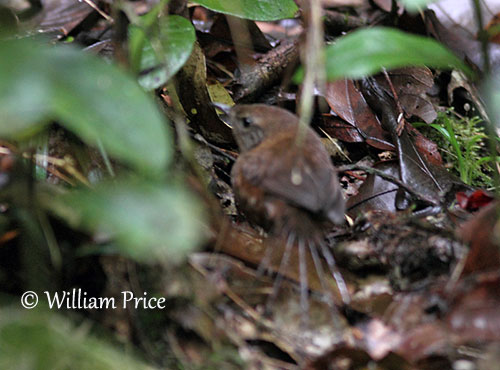
RANGE:
The Brown Emu-tail is restricted to E Madagascar.
HABITAT:
The Brown Emu-tail frequents the humid forest of the eastern part of the island. It is found in dense undergrowth within the rainforest, usually between 500 and 2,500 metres of elevation.
CALLS AND SONGS: SOUNDS BY XENO-CANTO
The Brown Emu-tail’s call is a short, rolling rattle “ptrrrrr”.
The song is a duet given by both mates, but it differs slightly according to the region.
In N and C, it starts by high-pitched “see see see” followed by “twiwiwi” or more rapid and slightly higher “twirra”.
In SE, the song is a harsher “tch-tch-tch” followed by high-pitched “chirrrr” and slow, low “wi-wi-wi”.
BEHAVIOUR IN THE WILD:
The Brown Emu-tail feeds on small insects caught in the vegetation. It forages close to the ground in damp herbaceous areas, often running rather than flying.
It is usually solitary and very secretive. It moves rapidly among the low, tangled vegetation. It sings from the cover, rarely from exposed perches.
The breeding behaviour of this species is unknown.
The Brown Emu-tail is sedentary on the island.
It rarely flies and only over short distances. It prefers to creep along the ground in mouse-like manner.
REPRODUCTION OF THIS SPECIES:
The Brown Emu-tail nests among dense vegetation, and the nest is placed near the ground.
The female lays two eggs. No more information.
PROTECTION / THREATS / STATUS:
The Brown Emu-tail has restricted range in the wet forest of E Madagascar. It is locally fairly common to abundant, but in the future, the continued deforestation will involve some decline of the population.
But currently, the Brown Emu-tail is not globally threatened and evaluated as Least Concern.
Fr: Droméocerque brun
Ang: Brown Emu-tail
All: Madagaskarbuschsänger
Esp: Yerbera Colilarga
Ita: Emuro bruno
Nd: Madagaskarstruikzanger
Sd: stråstjärtad smysångare
Mal: jijimaitso, Serika
Photographer:
William Price
PBase-tereksandpiper & Flickr William Price
Text by Nicole Bouglouan
Sources:
HANDBOOK OF THE BIRDS OF THE WORLD Vol 11 by Josep del Hoyo, Andrew Elliott and David Christie - Lynx Edicions - ISBN: 849655306X
Birds of Madagascar and the Indian Ocean Islands Par Roger Safford, Adrian Skerrett, Frank Hawkins – ISBN: 1472924118, 9781472924117- Editeur: Bloomsbury Publishing, 2015
The Birds of Africa: Volume VIII: The Malagasy Region: Madagascar, Seychelles, Comoros, Mascarenes - Par Roger Safford, Frank Hawkins – ISBN: 1408190494, 9781408190494- Editeur: A&C Black, 2013
Brown Emu-tail
Bradypterus brunneus
Passeriformes Order – Locustellidae Family
INTRODUCTION:
The Brown Emu-tail is endemic to Madagascar. It is placed in the subfamily Acrocephalinae, in the large family Sylviidae that gathers the Old World warblers. It was formerly placed in the genus Dromaeocercus, alongside the Grey Emu-tail (now in genus Amphilais), because of similarities in tail structure. It is now placed in the genus Bradypterus because it exhibits features associated with the bush-warblers in the subfamily Acrocephalinae.
It frequents the dense undergrowth of humid tropical forests, between 500 and 2,500 metres of elevation in the eastern part of the island. Its warm brown plumage makes it very difficult to find.
The Brown Emu-tail is not globally threatened, but it has restricted range. However, the continued deforestation will be a cause of decline of the population in the future.
DESCRIPTION OF THE BIRD:
Biometrics:
Length: 15 cm
The Brown Emu-tail has short wings and long, graduated tail made of six rectrices reduced only to dark shafts.
It has russet-brown upperparts, upperwing-coverts and tertials. The flight feathers are blackish-brown with dark russet-brown edges.
The underparts are orange-brown. Flanks and undertail-coverts are darker. Underwing-coverts and axillaries are orange-brown.
Top and sides of head are dark tawny-brown. We can see a narrow, pale cinnamon-brown supercilium extending to above the ear-coverts. Lores and cheeks are dark greyish-brown whereas ear-coverts are greyish-brown with some whitish shaft streaks. Centre of chin and throat are buffy white.
The bill is blackish-brown. The eyes are dark brown. Legs and feet are pinkish.
Male and female are similar.
The juvenile is dark tawny-brown overall, and the tail is fully formed.
